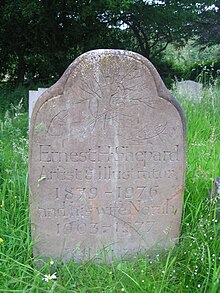Career


Shepard was born in St John's Wood, London. Having shown some promise in drawing at St Paul's School, Shepard enrolled in Heatherleys School of Fine Art in Chelsea.[1] Having spent a productive year there, Shepard won a scholarship to the Royal Academy Schools [2] where he would meet Florence Eleanor Chaplin who would become his first wife.[3] By 1906 Shepard had become a successful illustrator, having produced work for illustrated editions of Aesop's Fables, David Copperfield, and Tom Brown's Schooldays, as well as an illustration for Punch.[4]
In 1915, Shepard received a commission in the Royal Garrison Artillery, an arm of the Royal Artillery.[5] By 1916 Shepard started working for the Intelligence Department sketching the combat area within the view of his battery position.[6] In 1917 whilst commissioned as a 2nd Lieutenant, and acting as Captain, he was awarded the Military Cross for his service at the Battle of Passchendaele during World War I. His citation read:[7]
For conspicuous gallantry and devotion to duty.
As forward Observation Officer he continued to observe and send back valuable information, in spite of heavy shell and machine gun fire. His courage and coolness were conspicuous.
By war's end, he had achieved the rank of major.[8]
Throughout the war he had been contributing to Punch. He was hired as a regular staff cartoonist in 1921 and became lead cartoonist in 1945 but was removed from this post by Malcolm Muggeridge, who became editor in 1953.[9]
Shepard was recommended to Milne by another Punch staffer, E. V. Lucas in 1923. Initially, Milne thought Shepard's style was not what he wanted, but used him to illustrate his book of poems When We Were Very Young. Happy with the results, Milne insisted Shepard illustrate Winnie-the-Pooh. Realising his illustrator's contribution to the book's success, Milne arranged for Shepard to receive a share of his royalties. Milne also inscribed a copy of Winnie-the-Pooh with the following personal verse:[10]
When I am gone,
Let Shepard decorate my tomb,
And put (if there is room)
Two pictures on the stone:
Piglet from page a hundred and eleven,
And Pooh and Piglet walking (157)…
And Peter, thinking that they are my own,
Will welcome me to Heaven.
Eventually, Shepard grew to resent "that silly old bear" and felt that these illustrations overshadowed his other work.[11]
Shepard modelled Pooh not on the toy owned by Christopher Robin, Milne's son, but on "Growler", a stuffed bear owned by his own son (Growler no longer exists, having been given to his granddaughter Minnie Hunt and subsequently destroyed by a neighbour's dog).[12] His Pooh work is so famous that 300 of his preliminary sketches were exhibited at the Victoria and Albert Museum in 1969, when he was 90 years old.[13]
An E.H. Shepard painting of Winnie the Pooh is the only known oil painting of the famous teddy bear. It was purchased at an auction for $243,000 in London late in 2000.[14] The painting is displayed at the Pavilion Gallery in Assiniboine Park, Winnipeg, Manitoba, Canada.[15]
Shepard wrote two autobiographies: Drawn from Memory (1957) and Drawn From Life (1961).[16][17]
In 1972, Shepard gave his personal collection of papers and illustrations to the University of Surrey. These now form the E.H. Shepard Archive.[18]
Shepard was made an Officer of the Order of the British Empire in the 1972 Queen's Birthday Honours.[19]
